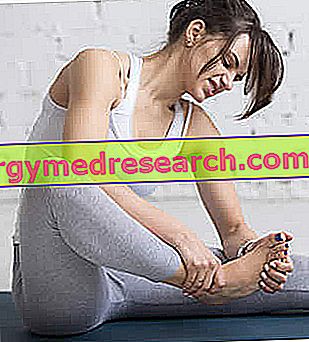Generality
The distortion is an injury of the musculoskeletal system, characterized by the temporary alteration of the anatomical relationships that exist between the elements of the affected joint; this event involves damage to one or more components of the joint involved.

The main risk factors of distortion include: physical-sporting activity, insufficient muscle tone and a sedentary lifestyle.
An articulation that has undergone a distortion is painful, swollen and rigid, has lost part of its characteristic mobility, is unstable and noisy and, finally, presents a more or less extensive hematoma around itself.
For an accurate diagnosis of distortion, physical examination, anamnesis, X-rays and nuclear magnetic resonance are essential.
The treatment adopted in the case of distortion depends on the extent of the joint damage that has occurred. For mild or moderate damage, therapy tends to be conservative; for serious damage, however, surgery is planned.
Short review of the joints
The joints are anatomical structures, sometimes complex, which put two or more bones in mutual contact. In the human skeleton, they are around 360 and perform functions of support, mobility and protection.
According to the most common anatomical view, there would be three main categories of joints:
- Fibrous joints (or synarthrosis ). They generally lack mobility and the constituent bones are held together by fibrous tissue. Typical examples of synarthrosis are the joints between the bones of the skull.
- Cartilaginous joints (or amphiarthrosis ). They have poor mobility and the constituent bones are joined by cartilage. Classic examples of amphiarthrosis are the joints that connect the vertebrae of the spine.
- Synovial joints (or diarthrosis ). They are highly mobile and include various components, including: the articular surfaces and the cartilage that covers them, the joint capsule, the synovial membrane, the synovial bags and a series of ligaments and tendons.
Typical examples of diarthrosis are the joints of the shoulder, knee, hip, wrist and ankle.
What is a distortion?
The distortion is an injury to the musculoskeletal system, which is characterized by a temporary modification of a synovial joint and the consequent damages - more or less serious - to the relative articular components (ligaments, joint capsule and cartilage, first of all; articular surfaces, tendons, synovial bags etc., secondly).
Sprains can affect any synovial joint. However, due to the particular position they occupy in the human body, some synovial joints (eg ankle and knee) are more at risk of distortion than others (eg: elbow or wrist).
What is meant by temporary modification?
The term "temporary modification of a synovial joint" means that, in episodes of distortion, the joint involved undergoes an anatomical alteration of a few moments, after which it assumes its normal conformation again.
The interesting aspect of this anatomical alteration is that, despite its temporary nature, it has the ability to cause damage to one or more joint components.
Distortion or dislocation?
It is a common tendency to confuse distortion with dislocation . However, these two pathologies of the musculoskeletal system, which affect the synovial joints of the human body, show a distinct difference. In fact, while the articular anatomical modification is only temporary in the distortion, in the case of dislocation it is permanent, resulting in the loss of contact between the bone portions that form the joint in question.
Causes
Generally, a joint is the victim of a distortion in two circumstances:
- When it performs an unnatural movement, that is beyond its physiological limits;
Or
- When it suffers a trauma or a bruise in a particularly delicate point.
If the unnatural movement or the trauma / contusion are severe, the damage to the affected joint can also be very deep.
Deep damage is understood as: severe alterations of the joint capsule, total lacerations of ligaments or tendons, injuries to the articular cartilage, etc.
If, on the other hand, the unnatural movement or the trauma / contusion are contained, the joint damage is more modest (compared to the case just observed). With modest joint damage we refer to: slight alterations of the joint capsule, partial stretching or lacerations of ligaments or tendons, minimal or no cartilaginous suffering, slight inflammation of the synovial bursae etc.
Risk factors
According to the reliable opinion of doctors and industry experts, distortion risk factors are important:
- The practice of sport in which physical contact is foreseen, the race with sudden changes of direction and / or the execution of jumps, leaps etc. Such sports are football, rugby, basketball, American football, volleyball, tennis, some athletic specialties, etc.
- The inadequate warming of the musculoskeletal system before any physical activity of a certain intensity. The warming of the musculoskeletal system increases the supply of blood to the joints of the human body and to their individual components; the greater blood supply to the joints makes the latter more flexible, therefore with an improved ability to oppose unnatural movements;
- The presence of an insufficient muscle tone. The muscles guarantee support and stability in the joints that are in their vicinity; if they are weak, even the slightest unnatural movement of a joint can compromise the health of the latter.
An example of an important muscle for the solidity and stability of a joint is the femoral quadriceps (thigh muscle) towards the knee: the more the thigh is toned from the muscular point of view and the less are the chances that the knee will move beyond their physiological limits;
- The practice of physical activity after long periods of physical inactivity. This situation is connected in part to the previous point (insufficient muscle tone) and partly to the lack of elasticity of ligaments and joint tendons, due to prolonged physical inactivity.
Symptoms and complications
The typical symptoms and signs of a distortion are:
- Pain in the affected joint;
- Joint swelling;
- Reduced joint mobility;
- Joint stiffness;
- Presence of hematoma on and in the vicinity of the affected joint;
- Emission of sounds, such as crackles or creaking, with each movement of the joint.
If a distortion affects a lower limb, the patient is very likely to have problems walking, perceives a sense of instability at the level of the affected joint and is almost certainly incapable of running, jumping, etc.
Similarly, if a distortion affects an upper limb, the patient has problems performing the simplest manual tasks and, almost certainly, is unable to perform the most complex or heavy manual gestures (eg lifting weights).
To motivate this series of difficulties and incapacities is, mainly, pain: the movement of a joint, suffering due to a distortion, further increases the already existing pain sensation.
As can be seen from its possible consequences in everyday life, distortion is a condition that affects the quality of life of those affected, especially if the latter is an active person.
Knee sprain and ankle sprain
Knee distortion and ankle sprain are the two most well-known and common distortion examples.
Both are characterized by the consequences, sometimes very severe, on the ligaments and cartilages that cover the bony portions involved in the joint.
Among the ligaments of the knee, the most affected are the medial collateral ligament, the anterior cruciate ligament and the lateral collateral ligament; among the ligaments of the ankle, however, those most affected are the so-called lateral ligaments.
Complications
From the episodes of distortion, at least three relevant complications can arise:
- The fracture of one of the bony portions that form the affected joint. It is a short-term complication;
- The marked tendency, on the part of the affected joint, to injure itself again in the same way (recurrence). It is a long-term complication;
- The predisposition of the affected joint to develop a form of early osteoarthritis . It's another long-term complication.
In general, the aforementioned complications concern the most serious distortions, but there are always exceptions.
When should I go to the doctor?
An individual should contact his or her doctor, if the joint affected by the injury or inappropriate movement is particularly painful, swollen, rigid and not very mobile, emit abnormal noises during movement attempts and / or show signs of an internal hematoma.
Diagnosis
For a diagnosis of distortion that also includes the precise identification of the joint damage caused, it is essential to: physical examination, medical history, X-rays and nuclear magnetic resonance.
Physical examination and medical history
Physical examination and medical history are often sufficient to understand that a certain joint has been the victim of distortion.
However, they do not provide any other information. It is for this reason that doctors prescribe more detailed examinations.
X-rays and nuclear magnetic resonance
X-rays and nuclear magnetic resonance are the in-depth examinations, which allow the doctor to establish precisely what the joint damage produced by the distortion episode in the studio is.
X-rays show possible bone fractures, while nuclear magnetic resonance shows possible damage to soft tissues (eg ligaments, tendons, synovial bags, etc.) and cartilage.
Therapy
The treatment of a distortion depends on the extent of the joint damage present: in light and contained damages (eg: stretching of a ligament), doctors remedy by adopting a conservative treatment, as there is the possibility of self-repair by the affected joint ; on the contrary, to serious and profound damage (eg: rupture of the anterior cruciate ligament of the knee), doctors can remedy only through a reparative-reconstructive surgical treatment, followed by an adequate rehabilitation program (since only in this way is it possible to obtain the healing of the organization involved).
Conservative treatment
Conservative treatment for minor sprains involves:
- A period of absolute rest from all those activities and movements that favor the appearance of pain . Rest is essential to allow the various damaged joint components to heal properly and in the shortest possible time.
To know the precise duration of the rest period, it is essential to consult your doctor (an expert on distortion would be congenial), who will decide the timing based on the results of diagnostic investigations;
- The application of ice on the painful and swollen area . The use of ice has a remarkable anti-inflammatory power, which many people underestimate.
Normally, under conditions such as distortions, doctors recommend applying ice 4-5 times a day for at least 15-20 minutes.
- The compression bandage of the joint . The compression counteracts the swelling and, in the case of distortions in the joints of the lower limbs (eg: knee or ankle), reduces the sense of instability;
- The elevation of the limb presenting the damaged joint . By minimizing the flow of blood to the damaged area, elevation is an effective remedy against swelling, pain and the formation of large bruises.
It is particularly important in the acute phase, when the distortion concerns a joint of the lower limbs;
- The administration of a NSAID (Non-Steroidal Anti-inflammatory Drug) against inflammation and pain . Inflammation is a normal consequence of any process that damages tissues or anatomical structures.
A highly prescribed NSAID in case of distortion is ibuprofen;
- Some physiotherapy sessions . Physiotherapy is used to restore the muscle tone lost with forced rest and to give back to the affected joint the same flexibility it had before the distortion.
Neglecting physiotherapy exposes the patient to relapses.
Surgical treatment
During surgical interventions due to a severe distortion, the operating doctor (usually an orthopedist) repairs the articular elements, irremediably damaged and unable to heal independently, with substitutes or with special sutures.
For example, knee sprains with rupture of the anterior cruciate ligament involve replacing the aforementioned ligament, no longer functional, with a synthetic ligament, a ligament taken from a deceased donor or with a portion of the patellar tendon belonging to the same patient under operation .
The most commonly used surgical technique for the treatment of sprained joint damage is the so-called arthroscopy : it is a minimally invasive technique, which involves performing 2-3 small skin incisions and using a very particular instrument, called arthroscope.
The aforementioned rehabilitation program, which follows every surgical procedure for the treatment of severe joint damage, is essential to ensure proper healing; neglecting it would make the surgeon's performance in the operating room useless. Therefore, it is to be considered an integral part of surgical treatment.
Prognosis
As slight or serious as they are, the episodes of distortion are now circumstances that can be treated with good, if not excellent, results.
As can be guessed, healing times are not the same for all patients: those who are victims of slight distortion heal faster than those who are victims of severe distortion.
Healing times of mild or moderate distortion
To heal completely, a joint with mild or moderate distortion can take from a few days to a few weeks.
Healing times of a severe distortion
After surgery, to heal completely, a joint with a severe sprain may take from one to several months.
Prevention
To prevent distortion, it is essential to adopt all those precautions that limit risk factors.
For example, in sports, an athlete can prevent knee sprain and ankle sprain with adequate warm-up before each training or competition.



